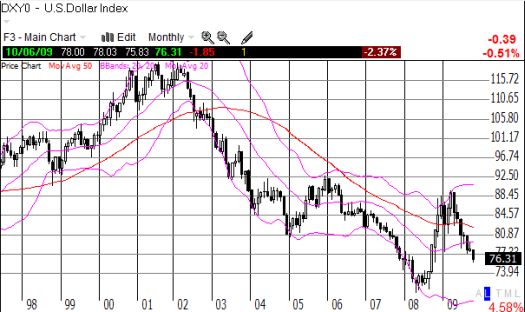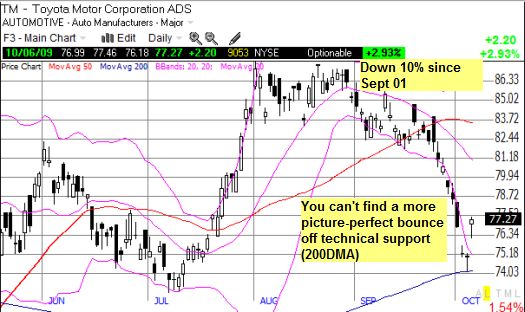Watching the U.S. dollar try to rally is like watching a wet noodle trying to stand up…in a downpour. The latest relief rally that I expected in the U.S. dollar came and went with a whimper. A week of lackluster meandering upward has ended with three days of selling, punctuated by the Reserve Bank of Australia’s surprise announcement that it will be the first G20 nation to raise interest rates.

The dollar may yet experience a “real” relief rally, but I have grown weary looking for it. The search is distracting me from the larger picture which is a 7-year and running slide which was briefly interrupted by a deflationary panic.

The dollar’s persistent decline toward fresh multi-year lows has begun to rattle some global finance ministers and the like. The U.S. dollar impedes their own desires for weaker currencies. Almost every major industrialized nation (except Australia, and maybe Canada) has sent signals to the foreign exchange markets to sell their currencies:
- Almost two weeks ago, Bank of England Governor Mervyn King confirmed Great Britain wants to export its way to prosperity and needs a weaker currency to do it.
- Shortly after that, Japanese Finance Minister Hirohisa Fujii was forced to backpedal on earlier comments implying he preferred a strong Japanese yen.
- Not be outdone, a chorus of voices from the Eurozone expressed concerns about the euro’s appreciation: (1) EU Commissioner Juaquin Almunia voiced his consternation, and most importantly (2) Jean-Claude Trichet led the ECB in a declaration of (pleading for?) support for a stronger dollar.
- Finally, all together now, the G20 recently appeared to agree that the dollar needs to be strong to lead the planet to a sustainable economic recovery.
This growing chorus of voices should have sent the dollar well on its way to loftier ground. No such luck. Apparently, currency traders remain too busy to listen, shorting more dollars to fund purchases of riskier assets with higher returns (the infamous carry trade). Jawboning alone will not reverse the downward momentum.
I was fortunate to play the dollar’s brief bounce by shorting the British pound. I will continue to look for fresh opportunities to do so. The pound weakened almost two weeks ahead of the dolar index’s most recent bottom.
I have started scaling into a long position in USD/JPY as I expect Japan to finally intervene (or some equivalent action) and arrest the rapid rise in the yen. The pressure must be building given the Nikkei has stumbled rapidly in the past week over concerns that the strong yen will hurt the exporters so critical to Japan’s economy. For example, Toyota (TM) is down 10% since the beginning of September even including today’s picture-perfect 3% bounce off the 200DMA.

So, the only way I am willing to play dollar weakness with currencies is to buy Australian dollars (currently long AUD/USD). I have finally purchased a small amount of FXA, the ETF for the Australian dollar, for the portfolio and will buy more if it corrects as much as 8% to the $82 level (not likely in the near-term…I really should have bought it 10% ago or so). FXA also carries a decent yield of 3%. Note that euro mainly controls the fate of the U.S. dollar index given it has a 58% weighting.
I still hold gold, still my favorite investment, and I am looking to scale back into positions in silver and copper. (Click here for a technical analysis suggesting an end-of-year target of $1200-1300 for gold).
In the meantime, be careful out there!
Full disclosure: long AUD/USD, USD/JPY, FXA, GLD

Hello from Russia!
Can I quote a post in your blog with the link to you?
Sure. No problem.